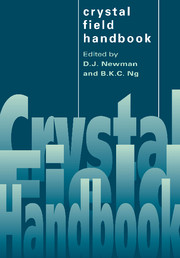Book contents
- Frontmatter
- Contents
- List of contributors
- Preface
- Introduction
- 1 Crystal field splitting mechanisms
- 2 Empirical crystal fields
- 3 Fitting crystal field parameters
- 4 Lanthanide and actinide optical spectra
- 5 Superposition model
- 6 Effects of electron correlation on crystal field splittings
- 7 Ground state splittings in S-state ions
- 8 Invariants and moments
- 9 Semiclassical model
- 10 Transition intensities
- Appendix 1 Point symmetry
- Appendix 2 QBASIC programs
- Appendix 3 Accessible program packages
- Appendix 4 Computer package CST
- Bibliography
- Index
Appendix 1 - Point symmetry
Published online by Cambridge University Press: 10 December 2009
- Frontmatter
- Contents
- List of contributors
- Preface
- Introduction
- 1 Crystal field splitting mechanisms
- 2 Empirical crystal fields
- 3 Fitting crystal field parameters
- 4 Lanthanide and actinide optical spectra
- 5 Superposition model
- 6 Effects of electron correlation on crystal field splittings
- 7 Ground state splittings in S-state ions
- 8 Invariants and moments
- 9 Semiclassical model
- 10 Transition intensities
- Appendix 1 Point symmetry
- Appendix 2 QBASIC programs
- Appendix 3 Accessible program packages
- Appendix 4 Computer package CST
- Bibliography
- Index
Summary
This appendix introduces all the relevant point group theoretical concepts and tools which are employed in this book. The aim is to explain the relationships between group theory and crystal field theory. No attempt is made to teach group theory. Readers who are interested in finding out about the mathematical details and understanding the basic theorems of group theory should refer to the standard texts, e.g. [Hei60, Sac63, Fal66, Tin64, LN69, ED79, But81].
Full rotation group O3 and free magnetic ionic states
A free magnetic ion is said to have spherical symmetry (see Chapter 1), which means that its Hamiltonian is invariant under all rotations about axes and reflections through planes which contain its centre of symmetry, i.e. its nucleus. The set of rotation operations through all angles about all axes passing through a given point, together with the inversion, form a group called the full rotation group O3. This group also contains, by construction, all the reflection operations through planes containing the given point. The wavefunctions (characterized by the symbols nlm) of a single electron in an electrostatic potential of spherical symmetry are obtained by solving the Schrödinger equation. They are given by the products of a radial function characterized by n and a spherical harmonic Ylm(θ, φ). The energy of states corresponding to a given wavefunction depends on the value of n and l only.
- Type
- Chapter
- Information
- Crystal Field Handbook , pp. 227 - 238Publisher: Cambridge University PressPrint publication year: 2000



